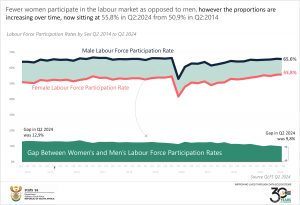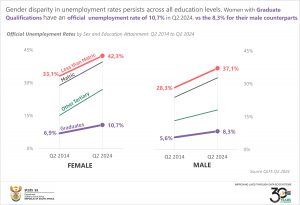South African Women Struggle with Unemployment and Workforce Inequality
“Wathint’ Abafazi, Wathint’ Imbokodo” (“You strike a woman, you strike a rock”) has become a powerful symbol of women’s strength and resistance. During Women’s Month, we celebrate the achievements of women in South Africa and the critical role they play in our society.
Regrettably, women in SA continue to shoulder a disproportionate burden of unemployment, underemployment, and lower workforce participation compared to men. This is partly because women are more likely to take on household duties, child-rearing, and other responsibilities that limit their opportunities in the labour market.
The trends in labour force participation and absorption rates for men and women from 2014 to 2024 indicate that fewer women have been participating in the labour market as compared to men.
The data shows a general increase in labour force participation rates for both men and women between Q2:2014 and Q2:2024. This increase was more substantial for women, rising to 55,8% in Q2:2024 from 50,9% in Q2:2014 (up by 4,9 percentage points), indicating a narrowing of the gender gap in labour force participation.
For women, Labor Force Participation Rates increased across all education levels except for those with other tertiary qualifications, who experienced a decline of 1 percentage point. The most significant increases in labour force participation were observed among women with less than a matric qualification (rising from 40,0% to 43,1% – an increase of 3,1 percentage points) and graduates (rising from 85,7% to 87,2%, an increase of 1,5 percentage points) over the 10-year period.
In terms of the absorption rate, men consistently reported higher rates than women from 2014 to 2024, with gender differences ranging from 9,0 to 12,5 percentage points. The absorption rate for women remained below 40,0%, declining by 1,1 percentage points from 36,9% in the second quarter of 2014 to 35,8% in the second quarter of 2024. The highest absorption rate for women was 38,3%, recorded in the first quarter of 2017.
Absorption rates for women declined across all education levels between Q2:2014 and Q2:2024, with more significant drops observed among those with other tertiary qualifications (10,5 percentage points) and those with a matric qualification (6,1 percentage points). In contrast, the decline was less pronounced for graduates and women with less than a matric qualification (1,9 percentage points each).
In contrast, the absorption rate for men rose from 48,7% in the second quarter of 2014 to a peak of 50,4% in the fourth quarter of 2015, before declining to 44,9% in the second quarter of 2024. Although labour force participation has improved, the findings indicate that labour absorption has worsened compared to a decade ago.
Over the 10-year span from Q2:2014 to Q2:2024, gender disparity in unemployment rates has persisted across all education levels in South Africa. Women, irrespective of their educational background—whether they have less than a matric certificate, a matric certificate, other tertiary qualifications, or a graduate degree—consistently face higher unemployment rates compared to men.
While both men and women have seen increases in unemployment rates across all educational categories during this period, the data highlights a disproportionately greater impact on women. The most significant rises were among women with other tertiary qualifications, where the unemployment rate jumped from 15,1% in Q2:2014 to 26,9% in Q2:2024, a rise of 11,8 percentage points, and those with a matric qualification, which increased from 28,8% to 39,5%, a rise of 10,7 percentage points. Women with graduate qualifications saw the smallest increase in unemployment, rising by 3,8 percentage points over the decade. In Q2:2024, their unemployment rate stood at 10,7%, which is higher than the 8,3% observed among men with similar qualifications.
The data reveals that the gap between absorption and labour force participation rates has widened for both genders. As this gap continues to grow, it suggests that a larger proportion of those entering the labour market are facing unemployment. For men, the gap increased from 15,2 percentage points in the second quarter of 2014 to 20,7 percentage points in the second quarter of 2024. For women, the gap expanded even more rapidly, rising from 14,0 percentage points to 20,0 percentage points over the same period.
Women’s Day serves as a powerful reminder of the ongoing struggle for gender equality and the urgent need to address gender disparities in various spheres, particularly in the labour market. Despite significant advancements in women’s rights, many still face challenges such as higher unemployment rates, underemployment, and barriers to career progression compared to men. These disparities not only affect women’s economic independence but also limit overall economic growth.
For more information, download the Quarterly Labour Force Survey, Q2:2024 here.



